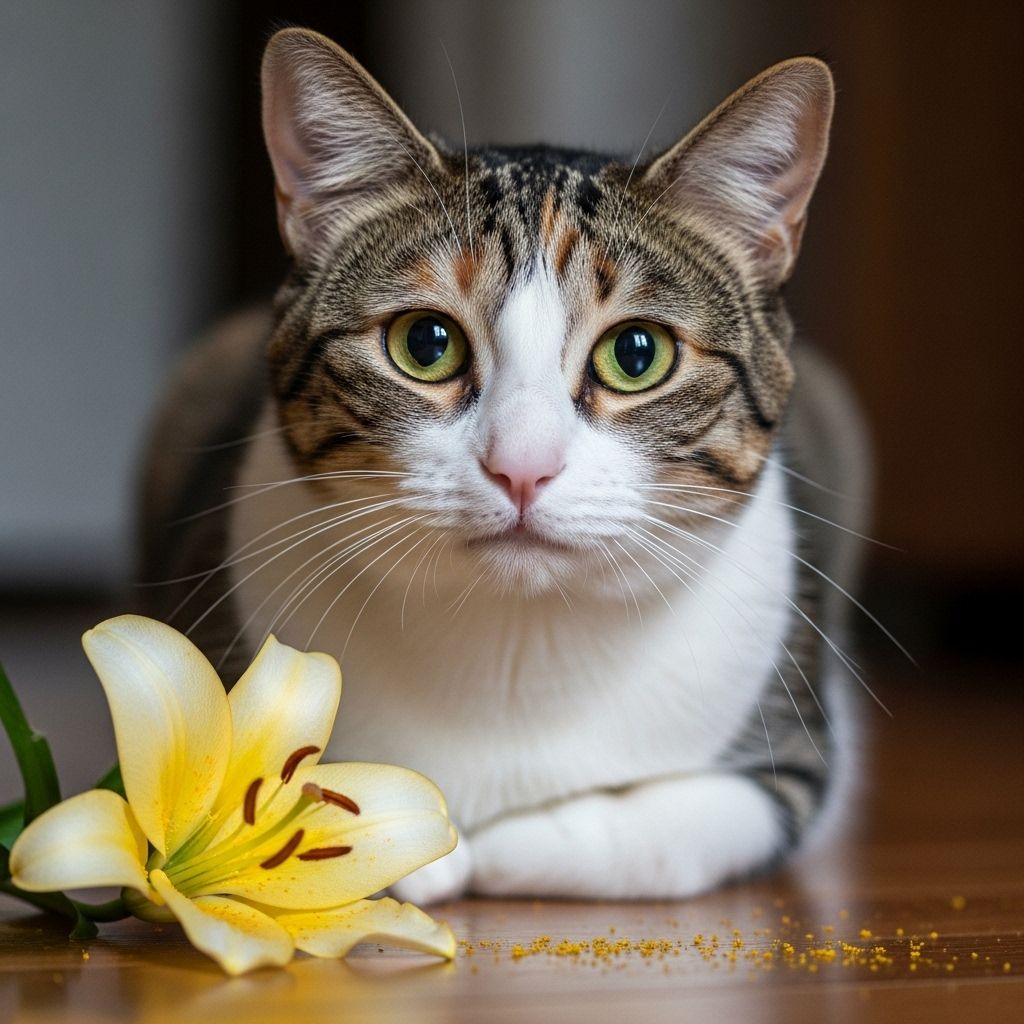Lily Poisoning in Cats: Causes, Symptoms, Treatment, and Prevention
Understand the severe risks lilies pose to cats, recognize poisoning symptoms early, and learn life-saving treatment and prevention strategies.

Lilies are a favorite ornamental flower in many homes and gardens, especially during spring and festive occasions. However, for cat owners, these beautiful plants harbor a hidden, life-threatening danger. Even minimal exposure to many lily species can prove catastrophic for felines, resulting in rapid-onset kidney failure and, without urgent intervention, death. This article explores the life cycle of lily poisoning in cats—from causes and symptoms to treatment options and ways to keep your pet safe.
Table of Contents
- What Are Lilies and Why Are They Dangerous?
- Which Species of Lilies Are Toxic to Cats?
- What Are the Signs of Lily Poisoning in Cats?
- What To Do If Your Cat Has Eaten or Touched a Lily
- How Vets Treat Lily Poisoning in Cats
- Prognosis: What to Expect After Lily Poisoning
- Prevention: How to Keep Your Cat Safe
- Frequently Asked Questions
What Are Lilies and Why Are They Dangerous?
Lilies are flowering plants belonging mostly to the Liliaceae and Hemerocallidaceae families, treasured for their delicate blossoms and pleasant scent. Yet, for cats, almost every part of these plants is toxic—including petals, leaves, pollen, stems, and even the water in a vase containing lilies.
The reason lilies are so dangerous to cats is not fully understood, but even small exposures often result in acute kidney failure within a matter of days. Lily ingestion can occur not only by chewing the plant, but also by grooming pollen from fur or drinking contaminated water.
Which Species of Lilies Are Toxic to Cats?
Lily toxicity varies between plant species. The following types of lilies are especially dangerous to cats:
- A true lily from the Lilium genus (e.g., Easter lily, tiger lily, Asiatic lily, stargazer lily)
- Daylilies (Hemerocallis species)
Other plants with “lily” in their names, such as peace lilies, calla lilies, and lily of the valley, either have different toxins or cause less severe symptoms. However, only true lilies and daylilies are known to cause sudden and irreversible kidney failure in cats.
| Lily Type | Botanical Name | Toxicity to Cats | Major Risk |
|---|---|---|---|
| Easter Lily | Lilium longiflorum | Extremely high | Acute kidney failure |
| Tiger Lily | Lilium lancifolium | Extremely high | Acute kidney failure |
| Stargazer Lily | Lilium orientalis | Extremely high | Acute kidney failure |
| Asiatic Lily | Lilium asiatica | Extremely high | Acute kidney failure |
| Daylily | Hemerocallis spp. | Extremely high | Acute kidney failure |
| Peace Lily (not a true lily) | Spathiphyllum | Mild to moderate | Irritation of mouth, GI upset |
| Lily of the Valley (not a true lily) | Convallaria majalis | Moderate | Heart arrhythmias |
What Are the Signs of Lily Poisoning in Cats?
The signs of lily toxicity often develop in stages, depending on the type and amount of lily ingested. Early intervention leads to better outcomes, so recognizing the signs is critical.
Immediate Signs (within 1–3 hours)
- Drooling and foaming at the mouth
- Vomiting
- Pawing at the mouth (pain)
- Vocalizing
- Lethargy, decreased activity
- Loss of appetite
First 12 Hours
- Persistent vomiting, sometimes self-limiting
- Diarrhea
- Ulcers or sores on the gums or in mouth
- Fast heartbeat
- Low blood pressure
12–24 Hours
- Kidney damage develops
- Increased thirst, urination
- Dehydration
- Depression, lethargy
- Tremors
24+ Hours
- Severe or fatal acute kidney failure sets in
- Lack of urination (anuric renal failure)
- Seizures
- Disorientation, inability to walk
- Coma, death
Other potential symptoms include:
- Ulcers or sores in the mouth and gums
- Dry mouth, dull coat, sunken eyes (signs of dehydration)
- Collapse
What To Do If Your Cat Has Eaten or Touched a Lily
Lily exposure is always an emergency for cats. Immediate action saves lives. If you witness your cat chewing or ingesting any part of a lily, suspect ingestion, or find chewed lilies in your home, act quickly:
- Call your veterinarian or the Pet Poison Helpline (855-764-7661) for urgent guidance.
- Transport your cat to a veterinary clinic or emergency vet right away.
- If possible, bring a sample of the plant for identification.
- If your cat is covered in pollen or plant material, bathing may be necessary – this is best performed at the vet’s office to avoid further stress and toxin exposure.
Do not attempt to induce vomiting at home. Safe and effective induction of vomiting in cats can only be done by a veterinarian.
How Vets Treat Lily Poisoning in Cats
There is no antidote for lily poisoning in cats. Early and aggressive veterinary intervention is key:
- Inducing Vomiting: If ingestion occurred within the last 2 hours, vets may induce vomiting to clear remaining plant material from the stomach.
- Activated Charcoal: Administered by mouth to bind residual toxins in the gut.
- IV Fluids: The mainstay treatment for lily toxicity. IV fluids support kidney function, maintain hydration, and help flush toxins from the system. Fluids are typically given for at least 48–72 hours.
- Lab Monitoring: Blood and urine tests monitor kidney function and guide treatment. Regular blood draws are critical during hospitalization.
- Supportive Care: Includes anti-nausea medications (e.g., maropitant), anti-vomiting drugs, and gastrointestinal protectants to ease stomach symptoms.
- Urinary Catheterization: May be necessary to monitor urine output when acute renal failure is a concern.
Important to Know:
- Once kidney failure is advanced and the cat stops producing urine (anuric renal failure), the prognosis is extremely poor, and even the most diligent therapy may not prevent death.
- There is no home remedy or cure for lily poisoning – only prompt, professional veterinary care can give your cat a chance at survival.
Prognosis: What to Expect After Lily Poisoning
Outcomes depend primarily on how soon your cat receives veterinary attention after exposure:
- If treated within 6 hours of ingestion, aggressive therapy can yield full recovery.
- Treatment started after 18–24 hours drastically reduces the likelihood of recovery, as kidney failure is more likely to be irreversible by then.
Some cats who survive may suffer permanent kidney damage, which will require ongoing management (e.g., special diets, medications, regular monitoring).
If left untreated, or if therapy is delayed beyond 24–48 hours, almost all affected cats die within 3–7 days due to irreversible kidney failure.
Prevention: How to Keep Your Cat Safe
The only truly effective strategy is complete avoidance of lilies if you have cats:
- Do not bring lilies of any kind into your home (cut flowers, potted plants, or bulbs).
- Avoid planting lilies in your garden.
- Educate family and friends about the risks lilies pose to cats – well-meaning gifts of bouquets can end in tragedy.
- Keep cats strictly indoors during times when lilies are common (spring, holidays, funerals, etc.).
Lily poisoning is common in cats, particularly those who roam outdoors or in households where lilies are used as decorations. Awareness and simple preventive measures are vital to protect your cat.
Frequently Asked Questions (FAQs) on Lily Poisoning in Cats
Q: Are all lilies toxic to cats?
A: True lilies (certain Lilium and Hemerocallis species) are extremely toxic to cats, causing acute kidney failure even with minimal contact. Other plants called “lily” (like peace lily or lily of the valley) can cause other symptoms but generally do not cause kidney failure.
Q: What if my cat just sniffs or brushes against a lily?
A: Even brushing up against lilies can deposit pollen on your cat’s fur, which may be ingested during grooming and still lead to poisoning. Any contact should be considered dangerous and treated as an emergency.
Q: Is there a home remedy or antidote for lily poisoning?
A: No. There is no antidote for lily poisoning. Do not attempt home treatment; professional, prompt veterinary intervention is required.
Q: How quickly do symptoms appear after exposure?
A: Symptoms can develop as quickly as 1–3 hours after ingestion, with kidney damage likely within 12–24 hours. Death due to kidney failure can occur as soon as 3 days post-exposure.
Q: What is the success rate of treatment?
A: Success depends on speed; treatment within several hours of exposure offers the best prognosis. Waiting more than 18–24 hours before starting treatment usually leads to severe, permanent kidney damage or death.
Q: Are dogs and other pets at risk?
A: Dogs may experience gastrointestinal upset with lily ingestion but do not suffer the rapid, fatal kidney injury seen in cats. Other species are generally less sensitive but may still be harmed by certain types of lilies.
References and Resources
- ASPCA Animal Poison Control Center
- Pet Poison Helpline
- Your local veterinary emergency hospital
- Trusted veterinary health websites and national animal health agencies
If you have any reason to suspect your cat may have eaten part of a lily, err on the side of caution: seek veterinary care immediately. Acting quickly can mean the difference between life and death.
Read full bio of Sneha Tete












